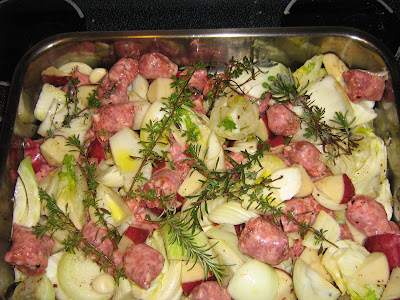 |
| Foto: Wikipedia |
Un dì l’estate scorsa, sognavo i sapori della moussaka. Simultaneamente sognavo i cavatelli, gloriosa pasta molisana che trovò la strada alla Puglia e, dopo, ad Ellis Island. Dalla mia gioventù a Boston, ho le bellissime memorie dei cavatelli di ricotta, più leggeri degli gnocchi ma con la stessa abilità di catturare il sugo.
Ecco due ricette, la prima in bianco (la mia improvvisazione dell’estate scorsa), la seconda in rosso (che ho fatto stasera). Sono innamorato all’impazzata di questi due piatti “greci.”
VERSIONE Iª: Cavatelli alla Greca, in bianco
Ingredienti
624 g cavatelli di ricotta
olivo d’oliva extra-vergine
2 grandi patate (non sbuciate), tagliate a cubettini (grandezza delle zollette di zucchero)
500 g agnello macinato
1/2 grande cipolla (oppure 1 cipolla piccola), tagliata a pezzettini
2 spicchi d’aglio, tagliati
1 limone, affettato (le estremità eliminate)
origano fresco
pepe giamaicano, frescamente macinato
cannella, frescamente macinata
noce moscata, frescamente macinata
sale
pepe nero, frescamente macinato
peperoncino secco
menta fresca
Feta fresca
Preparazione
1. Fate scaldare la padella. Aggiungete l’olio.
2. Aggiungete le patate, sale, pepe, e peperoncino. Fateli cucinare finché le patate sono dorate (5-10 minuti).
3. Aggiungete la cipolla, stando molto attento di non bruciarlo. (Ci vorrà forse un minuto, due massimo.)
4. Aggiungete l’aglio. Qualche
secondo dopo di aggiungere l’aglio, aggiungete l’agnello.

5. Quando una metà del color rosa se ne andrà dal carne (ci vorrà solo un paio di minuti), aggiungete le fette di limone.
6. Aggiungete 60-120 mL acqua dalla pasta.
7. Aggiungete il pepe giamaicano, la cannella, la noce moscata, e l’origano. (Aggiungeteli dopo di aver aggiunto il liquido, cosicché le erbe non si bruceranno.)
8. Il MOMENTO che l’agnello non è piú rosa, il piatto è finito. Non stracuocerlo.
9. Servitelo con la Feta frescamente grattugiata e alcuni ciuffi di menta.
Vino: Una falanghina sarebbe perfetta qua. Feudi di San Gregorio fa una falanghina fuori dal mondo.
VERSIONE IIª: Cavatelli alla Greca, in rosso
Ingredienti
624 g cavatelli di ricotta
olivo d’oliva extra-vergine
2 grandi patate (non sbuciate), tagliate a cubettini (grandezza delle zollette di zucchero)
500 g agnello macinato
1/2 grande cipolla (oppure 1 cipolla piccola), tagliata a pezzettini
2 spicchi d’aglio, tagliati
250 mL
aceto casereccio di vino rosso (oppure, 125 mL vino rosso e 125 mL aceto di vino rosso)
250 mL brodo CASERECCIO (di maiale, di manzo, oppure di pollame)
800 g pomodori pelati, passati nel frullatore
origano fresco
pepe giamaicano, frescamente macinato
cannella, frescamente macinata
noce moscata, frescamente macinata
sale
pepe nero, frescamente macinato
peperoncino secco
menta fresca
Feta fresca
Preparazione
A differenza della ricetta sopra, non volevo fare le patate nella padella. Le ho fatte bollire nell’acqua con i cavatelli. Nel frattempo, nella padella calda aggiungete l’olio, poi la cipolla e il peperoncino, poi l’aglio.
Un minuto dopo di aggiungere l’aglio, aggiungete l’agnello, sale, e pepe.
Quando una metà del color rosa se ne andrà dal carne (ci vorrà solo un paio di minuti), aggiungete l’aceto (oppure il vino e l’aceto). Quando bollisce, aggiungete il brodo.
Quando bollisce, aggiungete i pomodori.
Fatelo cucinare a media fiamma per una quindicina di minuti (dopo 7,5 di cui aggiungere l’origano).
Servitelo con la feta frescamente grattugiata e alcuni ciuffi di menta.
Diversamente dalla versione in bianca, questa versione in rosso produrrà un po’ più sugo che vi servirà.
Vino: Non conosco i vini greci, ma un vino pugliese, sia primitivo sia negroamaro, sarebbe perfetto. Li Veli fa una combinazione di primitivo e negroamaro che si chiama Primonero. Sarebbe come il fine del mondo con questo piatto.































